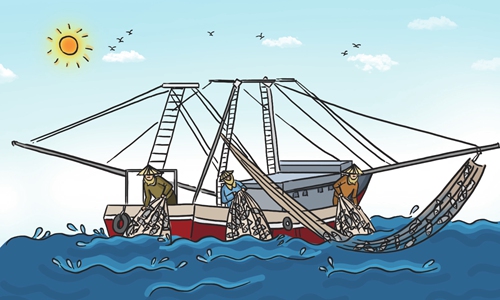Protecting fishery resources in South China Sea is key
By Hu Bo Source:Global Times Published: 2020/5/21 20:47:24

Illustration: Xia Qing/GT
After China announced its annual fishing ban in the South China Sea on May 1, Vietnam told its fishermen that they could continue fishing in legal areas. In terms of both fishing area and ship number, Vietnam is currently the country with the most fishery activities in the South China Sea.
According to data from the automatic identification system (AIS) of the South China Sea Strategic Situation Probing Initiative, there were 9,208 Vietnamese fishing ships operating in the South China Sea waters in April, including the Gulf of Thailand, and 9,152 in March. There are also more Vietnamese fishing ships that are not tracked by the AIS operating in the waters. Vietnamese fishing vessels even reached the waters of the Hainan island, the island of Taiwan, the Xisha Islands and the Nansha Islands, as well as those offshore of Malaysia, Indonesia and the Gulf of Thailand.
There would be no problem had Vietnam's fishing vessels operated in its territorial waters, but many have crossed into Chinese, Malaysian, Indonesian and Philippine waters that are not disputed by Vietnam. In April, more than 1,000 Vietnamese fishing ships intruded into the waters of China's Hainan island and Cambodia, as well at waters at the junction of Malaysia and Indonesia.
Illegal fishing has been a long-standing problem for Vietnam, and has frequently brought the country into conflict with other nations. Malaysia and Indonesia detain hundreds of Vietnamese fishing ships that intrude on their territorial waters. In October 2017, the EU also issued a warning to Vietnam over illegal, unreported, and unregulated (IUU) fishing. Although Vietnam has strengthened its regulations, their outcome is not yet obvious.
Vietnam's maritime militias and fishing vessels are the country's major means to "protect its rights and interests" in disputed waters. In recent years, Vietnam has put those means to use at a strategic level. Its total number of maritime militias is approaching 50,000, according to the country's official data. It shows that Vietnam is not likely to make up its mind about regulating its fishing activity.
Fishery resources in the South China Sea are depleting, and increased protections should not be delayed. Studies show that fishery resources in the South China Sea have reduced by one third in last three decades. According to the current developing trend, 59 percent of marine species will be lost by 2045.
China's annual fishing ban period is in place to protect resources and the environment. In disputed waters, China has several times called for a cooperative fishing ban. The South China Sea disputes will exist for a long time, but for common sustainable development, relevant countries have an obligation to take unilateral, bilateral or multilateral action to regulate their own fishing activities. Given the current situation, experts suggest parties should engage in promoting fishing management and scientific cooperation, rather than politicizing cooperation issues.
Though disputes can't be ruled out in the short term, considering the urgency of protecting fishery resources in the South China Sea, countries should avoid adding too much political and strategic color to normal fishing operations, and clear obstacles and restrictions for fishing cooperation in the South China Sea.
Hu Bo is the director of Research Center for Maritime Strategy at the Institute of Ocean Research, Peking University and the director of South China Sea Strategic Situation Probing Initiative. bizopinion@globaltimes.com.cn
Posted in: EXPERT ASSESSMENT